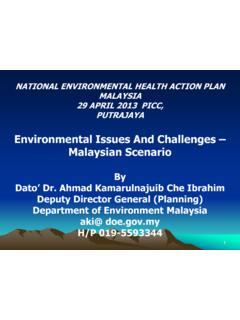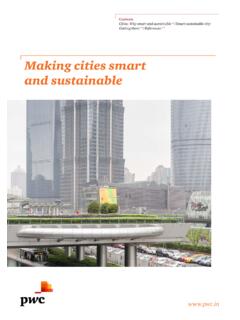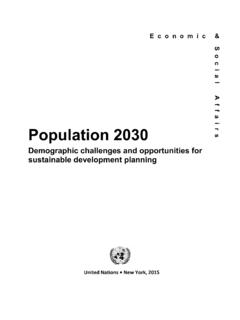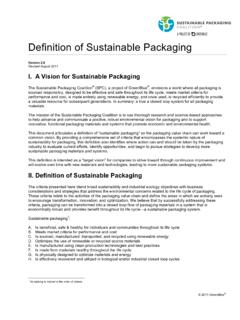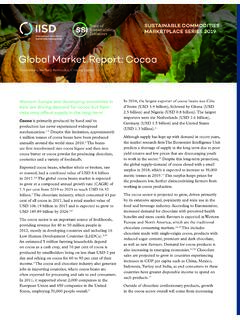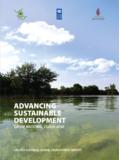Transcription of THE SUSTAINABLE DEVELOPMENT GOALS - World Health …
1 1 TOBACCO CONTROL & THE SUSTAINABLE DEVELOPMENT GOALS 2 WHAT ARE THE SDGs? The SUSTAINABLE DEVELOPMENT GOALS (SDGs) are a United Nations initiative, formally adopted by the United Nations General Assembly on 25 September 2015 in a resolution entitled Transforming our World : the 2030 Agenda for SUSTAINABLE DEVELOPMENT . The SDGs build on and succeed the Millennium DEVELOPMENT GOALS . They include 17 GOALS and 169 targets to be achieved over the next 15 years, with the aim to end poverty, protect the planet, and ensure prosperity for all as part of a new SUSTAINABLE DEVELOPMENT agenda.
2 WHY DO THE SDGs MATTER? The SDGs were endorsed by the United Nations and hence all of its 193 member countries. They are part of the United Nations programmes and processes. They were developed following a lengthy process of negotiation. They provide a remarkable commitment from governments to act, and a platform for those outside government to press for and participate in action in critical areas such as tobacco control. The SDGs represent a commitment at the highest levels to approaches and targets that will benefit humanity.
3 They do not stand alone, but as part of the 2030 Agenda for SUSTAINABLE DEVELOPMENT ; as such, they are much more than merely a declaration. Alongside the SDGs are governmental commitments to action that will enable progress towards the targets. The SDGs apply to all countries, rich and poor, and recognize the crucial interrelationship of Health , poverty, education, gender, and many other issues. WHICH GOALS ARE ESPECIALLY RELEVANT TO TOBACCO CONTROL? Reducing tobacco use plays a major role in global efforts to achieve the SDG target to reduce premature deaths from noncommunicable diseases (NCDs) by one third by 2030.
4 Many of the 17 GOALS have a direct or indirect relation to tobacco control. The most immediately relevant are the following. Goal 3: Ensure healthy lives and promote well-being for all at all ages. Goal 1: End poverty in all its forms everywhere. Goal 5: Achieve gender equality and empower all women and girls. Goal 10: Reduce inequality within and among countries. Goal 12: Ensure SUSTAINABLE production and consumption patterns. Goal 17: Strengthen the means of implementation and revitalize the global partnership for SUSTAINABLE DEVELOPMENT .
5 3 GOAL 3: ENSURE HEALTHY LIVES AND PROMOTE WELL-BEING FOR ALL AT ALL AGES A key target for Goal 3 is to strengthen the implementation of the World Health Organization Framework Convention on Tobacco Control (WHO FCTC) in all countries, as appropriate . The inclusion of tobacco control and WHO FCTC implementation as a key target recognizes the magnitude of the smoking epidemic. It indicates the priority that all countries should attach to tobacco control, the need to ensure evidence-based action on the basis of WHO FCTC recommendations, and the reality that Goal 3 cannot be implemented without a strong commitment to tobacco control.
6 Beyond this, several additional Goal 3 targets can be related to tobacco. By 2030 reduce by one-third premature mortality from noncommunicable diseases through prevention and treatment and promote mental Health and well-being. Strengthen the prevention and treatment of substance abuse, including narcotic drug abuse and harmful use of alcohol. Substantially increase Health financing and the recruitment, DEVELOPMENT , training and retention of the Health workforce in developing countries, especially in least-developed countries and small island developing states.
7 Strengthen the capacity of all countries, in particular developing countries, for early warning, risk reduction and management of national and global risks. As the NCD Alliance points out, almost two thirds of NCD deaths are linked to tobacco, alcohol, unhealthy diets and physical inactivity. The cost of inaction on NCDs far outweighs the cost of action. Further, investing in NCD reduction makes sense for SUSTAINABLE DEVELOPMENT it saves lives, promotes social cohesion, improves economies and supports a healthy planet.
8 WHO sets out the specific tobacco-related target of a 30% relative reduction in prevalence of current tobacco use by 2025. This ambitious but vital target is key to achieving the broader NCD target. It will require a strong commitment by governments and others to continuing action, as recommended by WHO. Commitment to strengthening implementation of the WHO FCTC is a crucial component of action by governments. The WHO FCTC, which came into force in 2005, is legally binding in 180 ratifying countries. It commits governments to implementing a comprehensive, evidence-based approach to tobacco control.
9 It also reflects the unique status of tobacco as the World s largest preventable cause of death and disease, and an issue for which we know exactly what needs to be done. Committing to support WHO FCTC implementation includes recognizing the importance of tobacco taxation and appropriate financing, as well as measures ranging from bans on tobacco advertising and promotion to excluding tobacco interests from having any influence in policy DEVELOPMENT . While Goal 3 is the most obviously applicable to tobacco, other GOALS are also relevant.
10 4 GOAL 1: END POVERTY IN ALL ITS FORMS EVERYWHERE Tobacco makes well documented contributions to increasing poverty, particularly in developing countries. Tobacco companies continually target disadvantaged countries and communities, thereby increasing Health disparities. Approximately 80% of the World s smokers are in low- and middle-income countries, where the burden of mortality and morbidity caused by smoking is increasingly felt. These countries will be most affected by the predicted increase in deaths from tobacco to 8 million each year by 2030.










